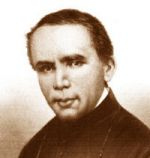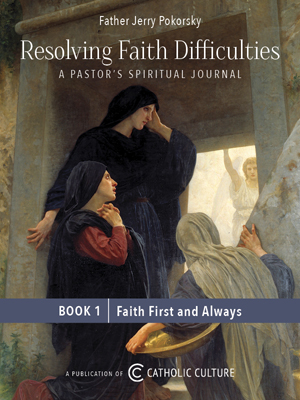Catholic Activity: Teaching Through Shrines
Supplies
- religious pictures or holycards
- cigar box
- oatmeal box
- flowers
- plants
- crepe paper
- colored paper
- aluminum foil
- soap
- scissors
- glue
- tape
- markers, crayons, colored pencils
Prep Time
5 hours
Difficulty
• • • •
Cost
$$ $ $
For Ages
3+
showActivity Types (1)
showLinked Activities (1)
Files (0)
Linked Recipes (0)
Linked Prayers (0)
Feasts (0)
Seasons (0)
Here the significance of a home shrine is explained, with descriptions of various possibilities. Children will want to participate in the loving act of decorating a shrine to Our Lady or especially the Christ Child.
DIRECTIONS
Something that can be most helpful in teaching religion to your children is a shrine. It need not be a large one of stone or marble as are many of the famous monuments of devotion. Actually, what we mean by a "shrine" is a setting for or display of a statue, cardboard figure, or picture of a religious subject. For instance, a May altar is a shrine, as is a Christmas crib or a grotto of Our Lady of Lourdes. If your home is one where the Sacred Heart has been enthroned, then you have a most impressive shrine.
The shrine can become a place for sacred play-activity involving a beloved friend in heaven. Any child will happily convert a cigar box or a circular oatmeal box into a shelter for Our Lady's image during May. He will be pleased to place a fresh flower there every day, because he knows that it pleases the Blessed Mother. A child learns responsibility and generosity in doing things for those in heaven and, as a result, will more easily do things for those on earth.
The ingenuity of parents and children is the only limit to materials for shrines. To provide a suitable background, you may start with a box or a shelf, or even a cave-like effect in the yard. Flowers, plants, crepe paper or aluminum foil may be used for decorating the statues, cards or pictures. Your child might choose to paint his own picture of the Blessed Mother. Some children carve figures out of soap. If you start a child on such a project and supervise and encourage his progress, he will without doubt enjoy it, and you will be gratified by his interest and achievement.
The First Christmas Crib It was the kind and gentle St. Francis of Assisi who first expressed his love for the Christ Child by making a Christmas crib. It occurred to him that others might feel a quickening of devotion if they could see that Mary was a human mother; that Joseph was a burdened husband, to whom she turned for guidance; that, on that first Christmas, the King of kings was a Baby who needed their love and protection. Francis found a cave outside the city, and in it he and some of his followers erected a representation of the scene of Bethlehem. Mass was offered there on Christmas day, and people were so enchanted by the scene and the idea that the Crib became a yuletide custom.
The Real Meaning of Christmas You, too, will want to have a Crib at Christmas time. After all, the scene of the Nativity provides the essential spirit and true meaning of Christmas. In your holiday arrangements, let the Crib have the place of honor. Permit it to dominate your living room, rather than place it in a dim or obscure corner. Let it proclaim to all the holiday visitors that in your family the birth of the Christ Child is the whole reason for the celebration of Christmas. Let it be understood at a glance that the gifts and tinsel and all the rest of the usual setting are incidentals and not causes of the observance.
Many families have a traditional set of figures to place in the Crib. These are carefully taken out of their storage box each year and suitably arranged. The children look forward to the appearance of the familiar set and some day they will no doubt choose to continue the tradition themselves in their own homes. If you do not own a set of figures, you can make a very satisfactory Crib out of cardboard-mounted pictures. Or you might secure one of the cardboard sets which are regularly advertised in Catholic magazines and newspapers.
In itself the Crib helps to tell the Christmas story to the children. The events can progress in proper order if you add the figures of the shepherds at first and, later, on January 6, the Feast of the Epiphany, those of the three Wise Men.
Permanent Shrines Besides the seasonal shrines in May and December. there are also shrines which have a place in the home all year. Each bedroom may have a simple shrine to the occupant's patron saint. Boys often choose St. Michael the Archangel. The girls may admire the Little Flower (St. Therese), or St. Agnes. You, Mother, can arrange a shrine to Our Lady in the kitchen to remind yourself and the children that the toil of homemaking can bring merit and can teach us about Mary, who did the same tasks for the Holy Family.
We know a family that has an outdoor shrine of Our Lady. The father made it and placed it at a turn of the driveway where all visitors see it. A vigil light and vases of (lowers are cared for by the three children of the family. Erecting such a permanent shrine gave the father a special and rare opportunity to work with and teach his children, while the children themselves became better acquainted with Our Lady. He was creating an impression that will always remain in the hearts of his children.
Indeed, the purpose of any family shrine is to honor the particular saint and to learn to know him and his virtues so that these can be developed in daily family life. You will find that you and your family have a sense of actually living with the saints when you bring them into your daily lives. This is a happy and wholesome outlook, for, after all, each of us hopes to be identified as a potential saint, at home with others who love God.
Activity Source: From Stroller to School, Parent-Educator Series 2, Leaflets 13-24, Three to Six Years by Confraternity of Christian Doctrine, Confraternity of Christian Doctrine, 1962
Subscribe to Insights...free!News, analysis & spirituality by email twice-weekly from CatholicCulture.org.Copyright © 2026 Trinity Communications. All rights reserved.






